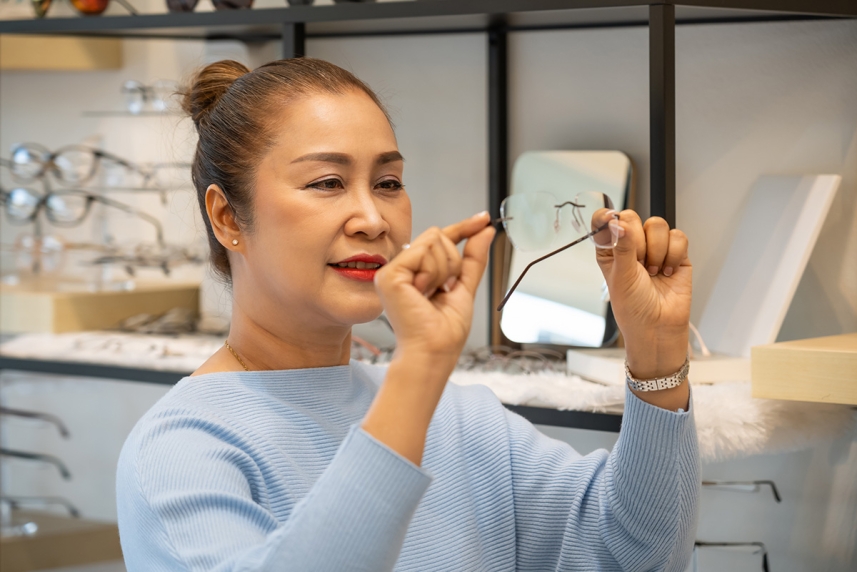Will wearing glasses instead of contact lenses save money?
It may depend on all sorts of factors — from a person’s eyesight and eye health to what type of vision coverage they have. Learn more.

Most people want to save money these days, even when they’re buying something that’s necessary for staying healthy. That may even extend to eyewear.
It may be tough to choose between a new pair of eyeglasses or contact lenses. Sometimes one or the other may save more money. It also depends on someone’s health plan. Some health plans may not include vision coverage or offer benefits for both eyeglasses and contact lenses. However, some health plans do, or they at least offer stand-alone vision plans that may help lower someone’s final costs.1
It also may make sense for an eye care provider to weigh in. They may understand the various costs involved when correcting a person’s vision, says Mile Brujic, O.D., an optometrist with the Premier Vision Group in Ohio and a member of the American Optometric Association.
“It truly depends on the individual’s eye care needs and what the eye doctor feels is the best option,” explains Dr. Brujic. Based on these choices, “either glasses may be less costly or contacts may end up being less,” he adds.
An eye care provider’s goal, like the patient’s, is to make the best choice for the eyes and wallet. So, here’s how an eye care provider may go about weighing the different factors to find the option that’s right for each patient.
UnitedHealthcare Vision offers a huge selection of designer eyeglasses — and vision insurance can help pay for them.
What might go into the cost of eyeglasses and contact lenses?
Many factors affect the cost of both eyeglasses and contact lenses. An eye care provider may walk people through the various options, advises Dr. Brujic.
Here are 6 common factors:
1. The lens prescription.
If a person requires corrective lenses to see either up close or at a distance, they may wear single-vision glasses — which are typically the least expensive option. But for those who may need multifocal glasses to see both near and far, lenses tend to be more expensive, especially progressive lenses.2, 3
2. The materials and coatings.
Plastic is the go-to substance for most lenses since it’s lighter and safer than glass. But specific materials and coatings may also be factors in cost. For eyeglasses, these options might include:2
- Polycarbonate lenses: These are stronger than regular plastic lenses and more shatterproof, so they’re good for people who play sports or work in more hazardous environments that require safety glasses
- Trivex: This newer type of plastic has similar strength to polycarbonate, has more clarity and is lighter weight.
- High-index: This thinner and more lightweight plastic is good for those who are very nearsighted (things appear blurry at a distance) or farsighted (things appear blurry up close).
- Anti-reflective coating: This coating reduces glare, especially for people with light-sensitive eyes or those who have trouble driving at night.
- Photochromatic coating: These are lenses that change from light to dark, depending on the light outside.
For more information about lens options, download this helpful guide.
Contacts, like glasses, are made of plastic. They can be hard or soft, or designed for daily wear or extended use.4 Depending on the type and materials, the prices may be drastically different too, says Dr. Brujic.
3. Fitting contacts or eyeglasses.
Contact lenses and eyeglasses both may need to be adjusted to the wearer, but contacts will initially take longer to fit. After people get their pair, there may be follow-up appointments to be sure they are comfortable and provide the best vision correction.5
Dr. Brujic also notes that the shape of the cornea may be another factor when fitting lenses. “For irregular corneas, a higher level of specialization is needed to fit the lens appropriately.”
4. Eye conditions.
Certain eye conditions may also drive up the cost of a pair of eyeglasses or contact lenses. For example, people with astigmatism or specific corneal diseases, may opt for specialty contact lenses, which may be a better fit for their corneas. These conditions may also affect whether soft or hard contact lenses may be a better choice. Hard contact lenses come in extended-wear versions, so they may be more convenient.4
5. Past lens history.
Established contact lens wearers already know which materials and types fit them. But for new wearers, “all of these things typically need to be tested to determine the best lens for their eyes,” explains Dr. Brujic. That may mean more fittings, since getting used to contact lenses may sometimes require trying different types before finding the best pair.
6. The cost of supplies.
Eyeglasses may be simpler to take care of. At most, people may just need a case and a cleaning cloth or solution to clean the lenses.
Taking care of contact lenses tends to be more involved. Lens wearers who opt for daily disposables may simply toss them away. But people who have extended-wear contacts need to make sure they’re cleaned and stored properly. Otherwise, the eyes may get infected.6
Contact lens wearers may need to buy a multipurpose cleaning solution or one made from hydrogen peroxide. People who wear contact lenses other than dailies will also need a case to hold the lenses in the solution and need to replace it at least every 3 months.6
Could wearing eyeglasses save people money?
Typically, yes. Contact lenses can’t be worn beyond a certain timeframe, says Dr. Brujic. They may warp, or a person’s cornea may change shape.7 So, they usually need to be replaced more often than a pair of eyeglasses.
“Plus, all contact lens wearers need to have a pair of glasses on hand for when they’re not wearing their contacts,” says Dr. Brujic. Even people who end up choosing contact lenses may need to buy a pair of eyeglasses as well.
Can vision plans lower the costs of eyeglasses or contact lenses?
The decision to pick eyeglasses, contact lenses or both may be affected by the type of vision coverage a person has. For eyeglasses, most UnitedHealthcare Vision plans offer people a frame allowance to spend every 2 years, depending on coverage. Standard lenses may be included at no additional cost once a year.
For people choosing contact lenses, many UnitedHealthcare Vision plans give them full coverage on select brands or an allowance toward other brands. There may also be an allowance provided for fittings.
“There are actually some vision plans that will cover almost the full cost of contact lenses if a person meets certain prescription requirements or needs them for medical conditions,” notes Dr. Brujic. This may be the case with a person’s UnitedHealthcare Vision plan, too.
To maximize benefits, it’s a good idea for people to go over the plan’s details carefully and discuss any questions that come up with their eye care provider, suggests Dr. Brujic. People may also contact the insurer itself. That way, it will be clear how the vision benefits in the plan apply to the person’s specific case.
No matter which option a person chooses, their eye care provider may guide them toward the best choice for their eye health and vision.
Ready to ditch your glasses or contacts and go for LASIK? Get more info about LASIK now.
Sources:
- Vision coverage Healthcare.gov.
- Eyeglasses: How to choose glasses for vision correction American Academy of Ophthalmology, June 2023.
- Pros and cons of progressive lenses American Academy of Ophthalmology, April 2023.
- Contact lenses for vision correction American Academy of Ophthalmology, May 2023.
- Types of contact lenses American Optometric Association.
- Contact lens care American Optometric Association.
- How to take care of contact lenses American Academy of Ophthalmology, April 2022.


